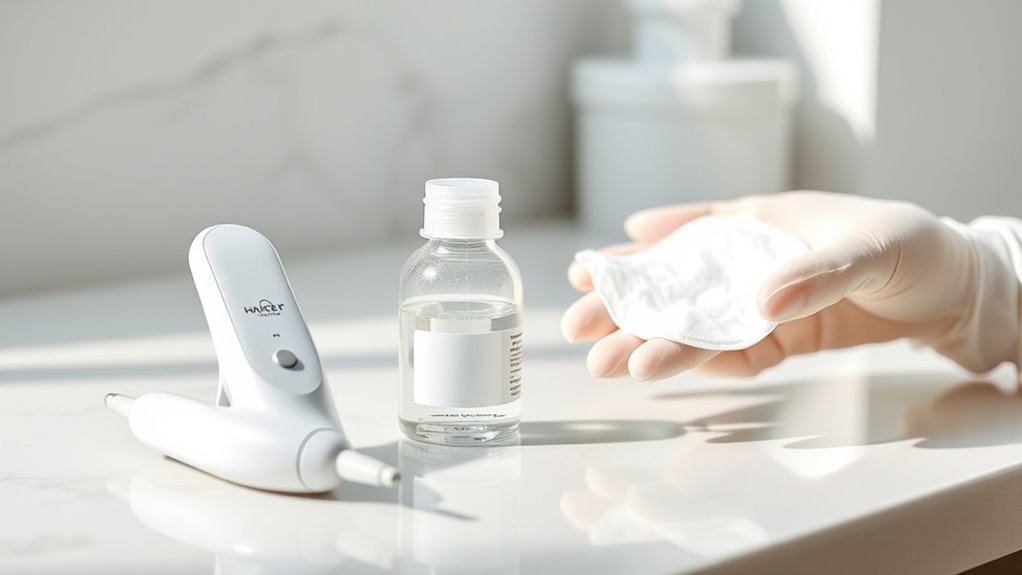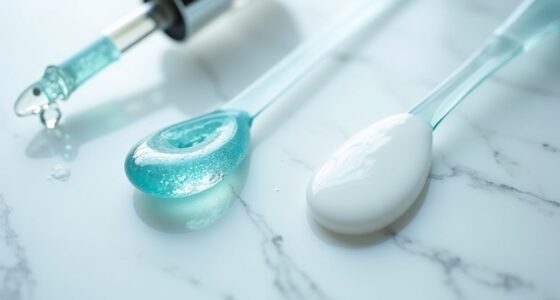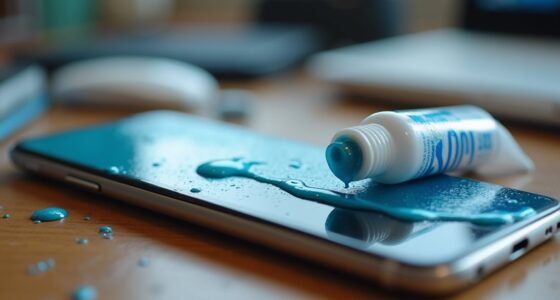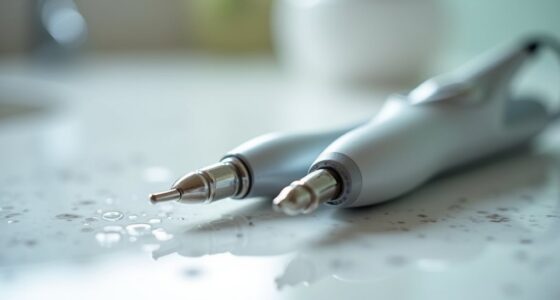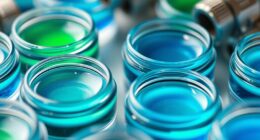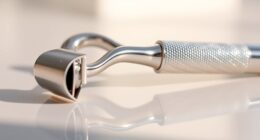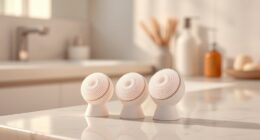To guarantee safe at-home microneedling, always sterilize your device thoroughly and avoid sharing it with others. Perform a patch test first and monitor your skin for reactions like redness or irritation. Keep your skin clean, apply soothing products afterward, and avoid harsh skincare or sun exposure during healing. Stay attentive to any severe reactions and stop use if needed. Want to learn more tips to protect your skin and maximize results?
Key Takeaways
- Always sterilize the device with alcohol or manufacturer-recommended disinfectant before each use.
- Perform a patch test on a small skin area to check for adverse reactions before full treatment.
- Avoid using harsh skincare products and sun exposure immediately after microneedling to prevent irritation.
- Use soothing, hydrating products like hyaluronic acid or aloe vera to support skin healing.
- Monitor skin for excessive redness, swelling, or blistering, and seek professional advice if adverse reactions occur.
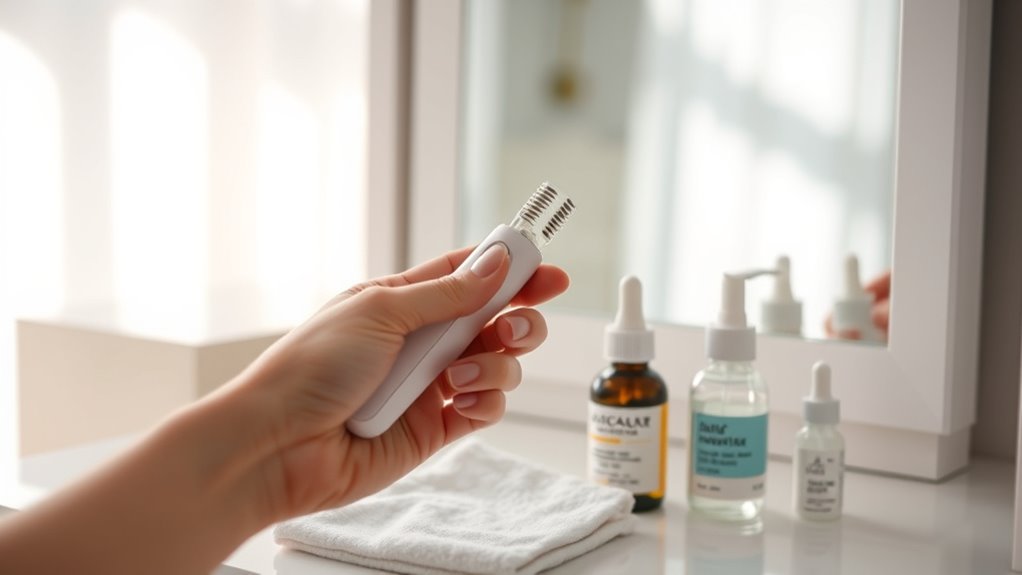
At-home microneedling can be an effective way to improve your skin, but it’s important to prioritize safety to avoid infection or skin damage. One of the most critical steps is ensuring proper device sterilization. Before you start, thoroughly clean your microneedling device with alcohol or a disinfectant recommended by the manufacturer. Avoid sharing your device with others, as this can transfer bacteria and increase infection risk. After each use, disinfect the device again, and store it in a clean, dry place to maintain its sterility. Proper device sterilization not only safeguards your skin but also extends the longevity of your tool, making your routine safer and more effective. Incorporating safety checklists can help you stay organized and ensure all precautions are followed.
Always sterilize your microneedling device before and after use to ensure safety and longevity.
Managing skin reactions is equally vital during at-home microneedling. Some redness, swelling, or mild irritation is normal immediately after the procedure, but you should monitor how your skin responds. If you notice excessive redness, persistent pain, or signs of inflammation, take a step back and give your skin time to recover. Avoid using harsh skincare products like retinoids or acids right after microneedling, as these can exacerbate irritation. Instead, opt for soothing, hydrating products containing ingredients like hyaluronic acid or aloe vera, which can help calm your skin. Applying a gentle, fragrance-free moisturizer can also support your skin’s healing process.
To minimize adverse reactions, perform a patch test on a small area of your skin before full treatment. This helps identify any potential allergies or sensitivities to your skincare products or the device itself. If you experience a skin reaction such as excessive redness, swelling, or blistering, stop using the device immediately and consult a healthcare professional. Keeping your skin clean and avoiding sun exposure after microneedling are also essential; UV rays can worsen irritation and prolong healing. Always wear broad-spectrum sunscreen if you need to go outside.
In addition, pay attention to your skin’s signals. If you notice a persistent or worsening reaction, don’t hesitate to seek advice from a dermatologist. They can help determine whether your skin is reacting normally or if you need to adjust your routine. Proper device sterilization and skin reaction management are crucial components of a safe at-home microneedling regimen. By following these practices, you can help ensure your treatments are effective while minimizing risks, protecting your skin’s health, and achieving the best possible results.
Frequently Asked Questions
Can I Use At-Home Microneedling Devices Daily?
You shouldn’t use your at-home microneedling device daily. Overusing it can cause skin irritation or damage. Make sure to properly sterilize your device before each use to prevent infection. Also, adjust the needle depth according to your skin’s needs, avoiding excessive penetration. Give your skin time to recover between sessions, typically every 4 to 6 weeks, to ensure safe and effective results while minimizing risks.
What Should I Do if I Experience Severe Skin Irritation?
If you experience severe skin irritation, treat it like a fire in your skin’s forest—act fast. Rinse your face with cool water, stop microneedling, and apply a gentle, fragrance-free moisturizer to protect your skin barrier. Consider an antihistamine if allergy management could be at play. If symptoms worsen or persist, consult a dermatologist promptly to prevent long-term damage. Your skin deserves quick, gentle care.
Are There Specific Skin Types That Should Avoid Microneedling?
If you have very sensitive skin or active skin conditions, you should avoid microneedling, especially for scar treatment. People with skin sensitivity may experience heightened irritation or adverse reactions. Those with eczema, psoriasis, or rosacea should consult a dermatologist before trying microneedling. Your skin type plays an essential role in how well your skin responds, so understanding your skin’s needs helps prevent complications and guarantees safe, effective treatments.
How Long Does It Take to See Visible Results?
You’ll typically see visible improvements within 3 to 4 weeks after starting at-home microneedling treatments. Timing expectations vary based on your skin’s condition and consistency, but with regular use, you should notice smoother texture, reduced scars, or improved tone over time. Keep in mind, patience is key, and maintaining a proper skincare routine enhances results, helping you achieve the best possible outcomes.
Can I Wear Makeup Immediately After At-Home Microneedling?
You shouldn’t wear makeup immediately after at-home microneedling because your skin needs time to heal. Applying makeup too soon can clog pores and irritate your skin, slowing down recovery. Wait at least 24 hours or until your skin feels fully healed before doing makeup application. This helps guarantee proper skin healing and reduces the risk of infection or irritation, giving you better, safer results.
Conclusion
Remember, at-home microneedling is like tending a delicate garden—you hold the tools with care, nurture your skin with patience, and respect its boundaries. Your skin is the canvas, and proper safety measures are the gentle rain that helps it flourish. When you prioritize cleanliness and follow guidelines, you’re planting seeds of confidence that will bloom over time. Treat your skin as the precious treasure it is, and watch your beauty grow naturally.
